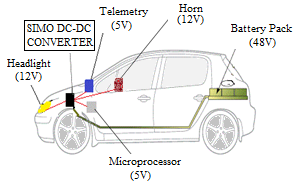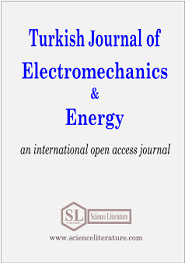
Single Input Multiple Output DC-DC Buck Converter for Electric Vehicles
Abstract
Increasing concerns on environmental pollution, global warming, depletion of the fossil fuel reserves and desire for reducing energy dependencies have led to an ever-increasing interest in electric vehicles (EV). The requirements for electric vehicles has brought many different problems and solutions in electric vehicle technology. One of these is the conversion of the voltage level from the battery in electric vehicles to other required voltage levels with DC-DC converters. As a solution, a separate converter can be used for each voltage level. Nevertheless, single-input multi-output (SIMO) converters can be used to reduce the cost and switching losses and hence improve system efficiency. In our study, we proposed non-isolated buck converter topology with single-input (48 V) and multi-output (12 V and 5 V). The 12 V voltage level is used for the horn, headlights while 5 V voltage level is used for the telemetry and microcontroller in electric vehicles. In this work, the general structure of a SIMO converter, design principles, small signal and stability analysis, and control steps are explained. The overall system has been simulated with Matlab / Simulink.
Full Text:
PDFReferences
P. U. Sanchis, and L. Marroyo, Adaptive voltage control of the DC/DC boost stage in PV converters with small input capacitor, IEEE Trans. Power Electron., 28(11), 5038–5048, (2013).
D. G. Chatterjee, and B. Fernandez, Modified soft-switched three-phase three-level DC–DC converter for high-power applications having extended duty cycle range, IEEE Trans. Ind. Electron., 59(9), 3362–3372, (2012).
N. M. L. Tan, T. Abe, and H. Akagi, Design and performance of a bidirectional isolated DC–DC converter for a battery energy storage system, IEEE Trans. Power Electron., 27(2), 1237–1248, (2012).
Z. Ouyang., Z. Zhang, O. C. Thomsen, and M.A.E Andersen, Planar-integrated magnetics (PIM) module in hybrid bidirectional DC–DC converter for fuel cell application, IEEE Trans. Power Electron. 26, (11), 3254–3264, (2011).
Z. Zhang, Z. Ouyang, O.C. Thomsen, and M.A.E. Andersen, Analysis and design of a bidirectional isolated DC–DC converter for fuel cells and supercapacitors hybrid system, IEEE Trans. Power Electron, 27(2), 848–859, (2012).
K. J. Ruan, K. Yang, and M. Xu, Power management for fuel cell power system cold start, IEEE Trans. Power Electron., 24(10), 2391–2395, (2009).
L. Wang, Z. Wang, and H. Li, Asymmetrical duty cycle control and decoupled power flow design of a three-port bidirectional DC–DC converter for fuel cell vehicle application, IEEE Trans. Power Electron, 27(2), 891–904, (2012).
V. A. Babazadeh, B. Ramachandran, L. Pao, D. Maksimovic, and E. Alarcon, Proximate time optimal digital control for synchronous buck dc-dc converters, IEEE Transaction on Power Electronics, 23(4), 2018–2026, (2008).
F. Lee, K. Yao, M. Xu, and M. Ye, Tapped-inductor buck converter for high-step-down DC-DC conversion, IEEE Transaction on Power Electronics, 20, 775–780, (2005).
D. Maksimovic, and X. Zhang, Multimode digital controller for synchronous buck converters operating over wide ranges of input voltages and load currents, IEEE Transaction on Power Electronics, 25(8), 1958–965, (2010).
K. Yao, Y. Qiu, M. Xu, and F. Lee, A novel winding coupled buck converter for high frequency, high-stepdown dc-dc conversion, IEEE Transaction on Power Electronics, 20, 1017–1024, (2005).
Y. Y. Mai, and P. Mok, A constant frequency output ripple-voltage-based buck converter without using large ESR capacitor, IEEE Trans. Circuits and Systems II, 55, 748–752, (2008).
P. Patra, A. Patra, and N. Misra, A single inductor multiple output switcher with simultaneous buck, boost, and inverted outputs, IEEE Trans. Power Electron., 27(4), 1936–1951, (2012).
A. Nami, F. Zare, A. Ghosh, and F. Blaabjerg, Multiple-output DC–DC converters based on diode-clamped converters configuration: Topology and control strategy, IET Power Electron., 3(2), 197–208, (2010).
B. K. Sabbarapu, O. Nezamuddin, A. McGinnis, and E. dos Santos. Single-input multiple-output synchronous DC-DC buck converter, IEEE Energy Conversion Congress and Exposition (ECCE), (2016).
D. Kwon, and G. A. R. Mora, Single-Inductor–Multiple-Output Switching DC–DC Converters, IEEE transactions on circuits and systems—ii: express briefs, 56(8), (2009).
E. C. D. Santos, Dual-output DC-DC Buck converters with bidirectional and unidirectional Characteristics, IET Transactions on Power electronics, 6(5), 999–1009, (2013).
M. S. Ebrahim, A. M. Sharaf, A. M. Atallah, and A. S. Emareh, An Efficient Controller for Standalone Hybrid-PV Powered System, Turkish Journal of Electromechanics and Energy, 2(1), (2017).
M. A. El-Sharkawi, Fundamentals of Electric Drives, CI-Engineering, (2.Edition), 68-73, (2000).
N. Mohan, Converters, Applications, and Design, John Wiley and sons Inc., (2. Edition), 161-200, (1995).
Q. Leu, J. W. Jung, T. D. Do, E. K. Kim, H. H. Choi, Adaptive PID Speed Control Design for Permanent Magnet Synchronous Motor Drives, IEEE Transaction on Power Electronics, 30(2), 900-908, (2015).
URN: https://sloi.org/urn:sl:tjoee2295
Copyright (c) 2017 Turkish Journal of Electromechanics and Energy

This work is licensed under a Creative Commons Attribution-NonCommercial 4.0 International License.

 Indexed in:
Indexed in:
















